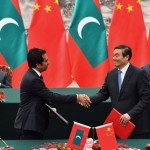Maldives, the smallest neighbour, which used to enjoy close relations with India, is moving rapidly into China’s sphere of influence. This seemed to be the upshot of Maldives president Abdulla Yameen’s most recent visit to Beijing in early December.
Of the nine cooperation agreements signed during the visit[1], two drew considerable attention in Maldives and the region. One relates to bilateral cooperation within the framework of China’s maritime silk road initiative, and the other is the Free Trade Agreement (FTA). The first fits into the broad pattern of other neighbours such as Pakistan, Sri Lanka and Nepal that are enamoured of the likely benefits of Chinese largesse without considering the costs and perils of excessive dependence on China’s long-term strategic designs.
The second agreement triggered a major controversy in Male.[2] The FTA provides for reduction of tariffs on 95% of the goods to zero. It also commits the two countries to open their service sector, covering finance, healthcare, and tourism, among others, and expand mutual cooperation. The difficulty is that Maldives’ exports to China are less than 1% of China’s to Maldives. Tariff-free entry of Chinese goods will thus be a huge one-sided advantage for Beijing while imposing a significant revenue loss on the Maldives. Domestic critics have also argued that with the services thrown open to large Chinese companies, the growth, the very existence, of Maldives-owned enterprises may be jeopardised.
Former president Mohamed Nasheed said that the FTA “will deepen the debt trap to China”. Others pointed to the undue haste and secrecy that accompanied the process by which parliamentary approval was obtained for signing the FTA just prior to the president’s visit to China.
The government has, of course, defended the agreement, for being beneficial to the people of the Maldives. Coming as a sequel to China’s already expanding footprint in infrastructure, tourism and other sectors, the FTA will increase the country’s dependence on Beijing in a crucial manner.
Mohamed Faisal, the Maldives ambassador in Beijing, wrote recently that bilateral relations in the past five years reached “a level of maturity and depth never seen before.”[3] The foundation for it, he stressed, was deepened “without doubt” by President Xi Jinping’s visit in September 2014, the first by a Chinese president to the Maldives.
This trend gathers momentum at a time of escalating divisions within the Maldives polity over the government’s handling of opposition and it’s showing scant respect for democratic norms: former president Nasheed remains abroad, in exile. He is currently living in Sri Lanka. Polarisation is likely to sharpen further as the country heads towards the next presidential election in 2018. Society is already grappling with the increased influence of Islamic elements that receive sizeable assistance from their supporters in Pakistan and the Gulf states, especially Saudi Arabia. All this could weld into a potentially explosive mix.
With SAARC continuing to be deadlocked, Maldives finds little opportunity to remain connected with South Asia. It is not a member of other regional groupings, either, such as Bangladesh Bhutan India Nepal (BBIN) and the Bay of Bengal Initiative for Multi-Sectoral Technical and Economic Cooperation (BIMSTEC). The trilateral maritime security cooperation, involving India, Sri Lanka and the Maldives, nurtured during 2011-2014, has made only limited progress. It may have lost some of its political momentum due to geopolitical changes in the region.
The India-Maldives relationship remains cordial, but a degree of estrangement does exist: Maldives is the only South Asian country that Prime Minister Modi is yet to visit. This contrasts also with the time when President Yameen, on his earlier visit to New Delhi in April 2016, said that Maldives was pursuing an ‘India First’ policy.[4] This was so during the years that Presidents Maumoon Abdul Gayoom and Nasheed governed the country respectively. Yameen’s claim about India being ‘first’ has since been met with growing skepticism while the positive impact of External Affairs Minister Sushma Swaraj’s visit to the Maldives in October 2015 seems to have worn thin.
Friends of the Maldives in India – and not just of the government – need to reflect on the future trajectory of the bilateral relationship and the direction it is taking – at a time when it prefers to pursue the ‘China First’ policy.
Rajiv Bhatia is Distinguished Fellow, Gateway House. A former ambassador to Myanmar, he is an expert on South Asian affairs.
You can read exclusive content from Gateway House: Indian Council on Global Relations, here.
For interview requests with the author, or for permission to republish, please contact outreach@gatewayhouse.in.
© Copyright 2017 Gateway House: Indian Council on Global Relations. All rights reserved. Any unauthorized copying or reproduction is strictly prohibited
References
[1] Rasheed, Rushdha, ‘China, Maldives signs controversy riddled Free Trade Agreement’, Raajje News, 13 December 2017, <https://raajje.mv/en/news/22717>
[2] Shaahunaaz, Fathimath, ‘Free trade pact would “sell off” Maldives to China: MDP’, Mihaaru, 4 December 2017, <http://en.mihaaru.com/free-trade-pact-would-sell-off-maldives-to-china-mdp/>
[3] Faisal, Mohamed, ‘Reflections on Maldives-China ties in the past five years’, Global Times, 22 October 2017, <http://www.globaltimes.cn/content/1071473.shtml>
[4] Embassay of India in Male, Maldives, Government of India, Maldives’ President says “Maldives pursues an India first foreign policy” – Raajje News, 11 April 2016, <http://www.eoi.gov.in/male/?4931>


